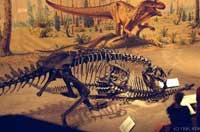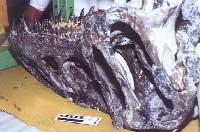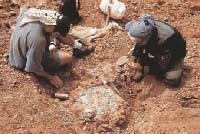Allosaurus bite
2001/02/22 Galarraga Aiestaran, Ana - Elhuyar Zientzia
Dinosaurs provoke fascination, while the representation of the bite of their gigantic teeth causes panic. Paleontologists passionately investigate dinosaur teeth to learn more about dinosaur anatomy and eating habits. Researchers at the University of Cambridge have used analytical methods and medical scanner techniques to learn about Allosaurus food biomechanics and have published their results in the journal Nature today.
Skull too large

The Allosaurus fragilis teropod was a carnivorous giant living in the Jurassic, of the same family as the Tyrannosaurus rex. Not much is known about its natural history or physical capacity, but thanks to the observed dental imprints, they know that large sauropods such as Apatosaurus were food of Allosaurus. He had in vain 80 saber-shaped teeth.
However, there have always been questions about the size of the Allosaurus skull, because it seemed too strong for its bite. Allosaurus bite of 1,400 kilos was much weaker than expected, such as the current wolf or leopard, and at least 6 times weaker than Tyranosaurus rex. Thanks to the research of the Cambridge team it has been possible to find out that the dinosaur Allosaurus used the skull unlike other predators of the same family.
Apparently, the predator had another way of hunting. He hunted his prey by hitting them with his head and, instead of crushing the flesh and bones, introduced his sharp teeth into soft tissues, causing the predator to bleed.
Paleontological Engineering
Until recently the only way to know the internal anatomical structure of dinosaur bones was by cutting the bones. In addition, the release of the skeleton from the rock posed a risk of damage. In recent years, paleontologists have resorted to medical and industrial techniques and have started using CT scans to separate themselves from the rock without destroying teeth and bones. In this way the internal and external morphology of fossils has been analyzed.
In the case of Allosaurus, taking advantage of the skull, they have been able to know better their functional morphology and their eating habits. These techniques, which can be used in other species, will help to know how they evolved through the study of the skull and teeth, including ecological factors.
There are many outstanding questions about the biology of dinosaurs. For example, whether or not the other teraphores had so many skulls, to what extent the mechanical importance of dinosaur cranial joints was so great and many more. An incipient path that combines mechanical engineering, paleontology, evolution, biology and comparative morphology will help answer these questions.

Gai honi buruzko eduki gehiago
Elhuyarrek garatutako teknologia





